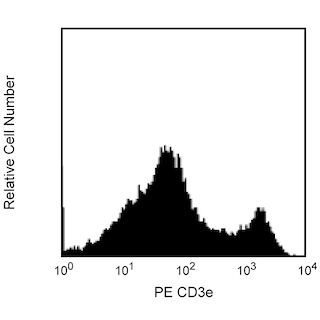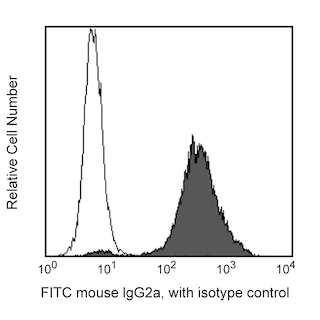Old Browser
Looks like you're visiting us from {countryName}.
Would you like to stay on the current country site or be switched to your country?




Two color analysis of NK-1.1 expression on splenocytes. C57BL/6NHsd splenocytes were incubated simultaneously with PE-conjugated anti-mouse CD3e mAb 145-2C11 (Cat. No. 553063/553064) and purified mAb PK136 (right panel), followed by FITC-conjugated anti-mouse IgG2a mAb R19-15 (Cat. No. 553390). NK-1.1+ CD3e- NK cells and NK-1.1[dim] CD3e+ NK-T cells are detected. Flow cytometry was performed on a BD FACScan™ flow cytometry system.


BD Pharmingen™ Purified Mouse Anti-Mouse NK-1.1

Regulatory Status Legend
Any use of products other than the permitted use without the express written authorization of Becton, Dickinson and Company is strictly prohibited.
Preparation And Storage
Product Notices
- Since applications vary, each investigator should titrate the reagent to obtain optimal results.
- Please refer to www.bdbiosciences.com/us/s/resources for technical protocols.
- Caution: Sodium azide yields highly toxic hydrazoic acid under acidic conditions. Dilute azide compounds in running water before discarding to avoid accumulation of potentially explosive deposits in plumbing.
- Sodium azide is a reversible inhibitor of oxidative metabolism; therefore, antibody preparations containing this preservative agent must not be used in cell cultures nor injected into animals. Sodium azide may be removed by washing stained cells or plate-bound antibody or dialyzing soluble antibody in sodium azide-free buffer. Since endotoxin may also affect the results of functional studies, we recommend the NA/LE (No Azide/Low Endotoxin) antibody format, if available, for in vitro and in vivo use.
Companion Products



.png?imwidth=320)
In the mouse, at least three members of the Klrb (Killer cell lectin-like receptor, subfamily b; formerly NKR-P1) gene family have been identified (Klrb1a/NKR-P1A, Klrb1b/NKR-P1B, and Klrb1c/NKR-P1C); but in the human gene family, a single homologue has been designated KLRB1, NKR-P1A, or CD161. The KLRB1/NKR-P1 family of proteins are type-II-transmembrane C-type lectin receptors. KLRB1C/NKR-P1C activates NK-cell cytotoxicity, while KLRB1B/NKR-P1B functions as an inhibitory receptor. KLRB1B/NKR-P1B protein has intracellular Immunoreceptor Tyrosine-based Inhibitory Motif (ITIM), while KLRB1C/NKR-P1C lacks ITIM and activates via association with Fc Receptor γ chain. Strikingly, KLRB1B/NKR-P1B and KLRB1C/NKR-P1C share 96% amino acid sequence identity in their extracellular C-type lectin domains. The PK136 antibody reacts with the NK-1.1 surface antigen (CD161c) encoded by the Klrb1c/NKR-P1C gene expressed on natural killer (NK) cells in selected strains of mice (eg, C57BL, FVB/N, NZB, but not A, AKR, BALB/c, CBA/J, C3H, C57BR, C58, DBA/1, DBA/2, NOD, SJL, 129) and the CD161b antigen encoded by the Klrb1b/NKR-P1B gene expressed only on Swiss NIH and SJL mice, but not on C57BL/6. Expression of KLRB1C/NKR-P1C protein is correlated with the ability to lyse tumor cells in vitro and to mediate rejection of bone marrow allografts. The NK-1.1 marker is useful in defining NK cells; however, the antigen is also expressed on a rare, specialized population of T lymphocytes (NK-T cells) and some cultured monocytes. Plate-bound PK136 mAb, in combination with low concentrations of IL-2, induces proliferation of a subset of NK cells.
This antibody is routinely tested by flow cytometric analysis. Other applications were tested at BD Biosciences Pharmingen during antibody development only or reported in the literature.
Development References (14)
-
Arase N, Arase H, Park SY, Ohno H, Ra C, Saito T. Association with FcRgamma is essential for activation signal through NKR-P1 (CD161) in natural killer (NK) cells and NK1.1+ T cells. J Exp Med. 1997; 186(12):1957-1963. (Biology). View Reference
-
Carlyle JR, Martin A, Mehra A, Attisano L, Tsui FW, Zuniga-Pflucker JC. Mouse NKR-P1B, a novel NK1.1 antigen with inhibitory function. J Immunol. 1999; 162(10):5917-5923. (Clone-specific: Immunoprecipitation). View Reference
-
Giorda R, Trucco M. Mouse NKR-P1. A family of genes selectively coexpressed in adherent lymphokine-activated killer cells. J Immunol. 1991; 147(5):1701-1708. (Biology). View Reference
-
Karlhofer FM, Yokoyama WM. Stimulation of murine natural killer (NK) cells by a monoclonal antibody specific for the NK1.1 antigen. IL-2-activated NK cells possess additional specific stimulation pathways. J Immunol. 1991; 146(10):3662-3673. (Clone-specific). View Reference
-
Koo GC, Dumont FJ, Tutt M, Hackett J Jr, Kumar V. The NK-1.1(-) mouse: a model to study differentiation of murine NK cells. J Immunol. 1986; 137(12):3742-3747. (Clone-specific: Depletion). View Reference
-
Koo GC, Peppard JR. Establishment of monoclonal anti-Nk-1.1 antibody. Hybridoma. 1984; 3(3):301-303. (Immunogen: Cytotoxicity, Flow cytometry). View Reference
-
Kung SK, Su RC, Shannon J, Miller RG. The NKR-P1B gene product is an inhibitory receptor on SJL/J NK cells. J Immunol. 1999; 162(10):5876-5887. (Clone-specific: Blocking). View Reference
-
Lanier LL. Natural killer cells: from no receptors to too many. Immunity. 1997; 6(4):371-378. (Biology). View Reference
-
Reichlin A, Yokoyama WM. Natural killer cell proliferation induced by anti-NK1.1 and IL-2. Immunol Cell Biol. 1998; 76(2):143-152. (Clone-specific: Induction). View Reference
-
Sentman CL, Hackett J Jr, Moore TA, Tutt MM, Bennett M, Kumar V. Pan natural killer cell monoclonal antibodies and their relationship to the NK1.1 antigen. Hybridoma. 1989; 8(6):605-614. (Clone-specific: Immunoprecipitation). View Reference
-
Sentman CL, Kumar V, Koo G, Bennett M. Effector cell expression of NK1.1, a murine natural killer cell-specific molecule, and ability of mice to reject bone marrow allografts. J Immunol. 1989; 142(6):1847-1853. (Clone-specific: Depletion). View Reference
-
Vicari AP, Zlotnik A. Mouse NK1.1+ T cells: a new family of T cells. Immunol Today. 1996; 17(2):71-76. (Biology). View Reference
-
Yokoyama WM, Seaman WE. The Ly-49 and NKR-P1 gene families encoding lectin-like receptors on natural killer cells: the NK gene complex. Annu Rev Immunol. 1993; 11:613-635. (Biology). View Reference
-
Yu YY, Kumar V, Bennett M. Murine natural killer cells and marrow graft rejection. Annu Rev Immunol. 1992; 10:189-213. (Biology). View Reference
Please refer to Support Documents for Quality Certificates
Global - Refer to manufacturer's instructions for use and related User Manuals and Technical data sheets before using this products as described
Comparisons, where applicable, are made against older BD Technology, manual methods or are general performance claims. Comparisons are not made against non-BD technologies, unless otherwise noted.
For Research Use Only. Not for use in diagnostic or therapeutic procedures.
Report a Site Issue
This form is intended to help us improve our website experience. For other support, please visit our Contact Us page.